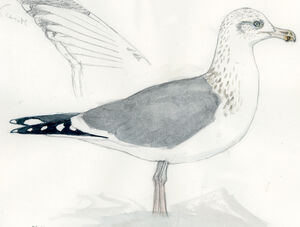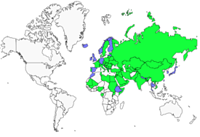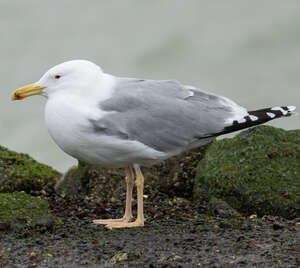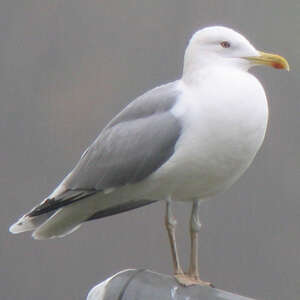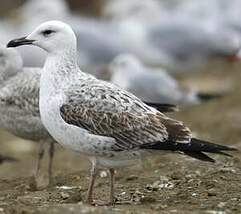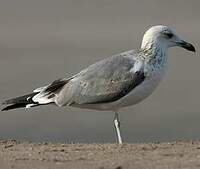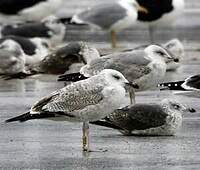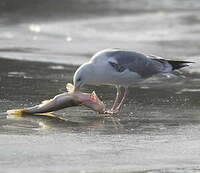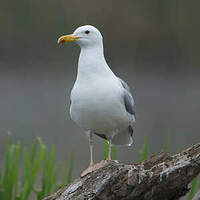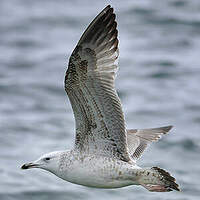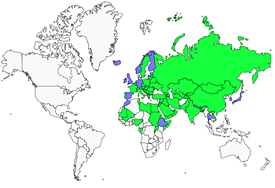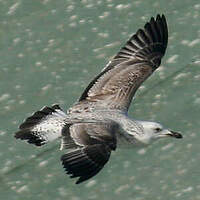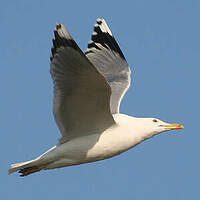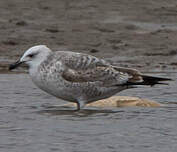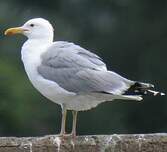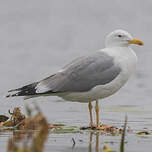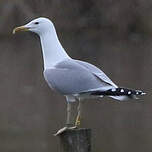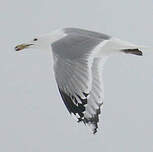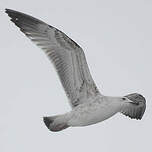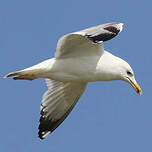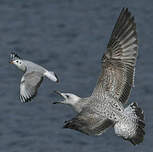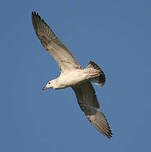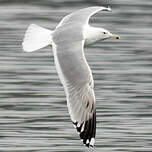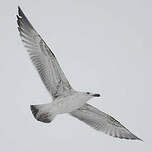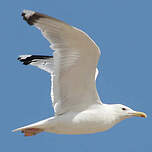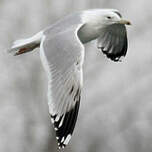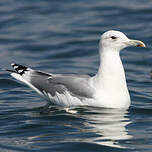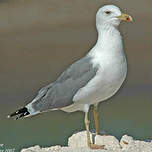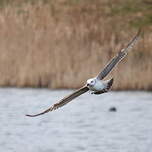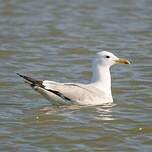Caspian Gull
Larus cachinnans - Goéland pontique
Identification
The Caspian Gull, previously a subspecies of G. leucophea L. michahellis cachinnans, has become a distinct species, a monotypic Larus cachinnans species. It forms with the former, but also with the G. argenté, with which it is known to hybridize in Poland, a group of large closely related gulls, with the identification problems that entail.
The Caspian Gull has a particular silhouette which comes into play in identification. It stands tall, with a strong chest, a fairly long neck and a rather small head. This head has a receding forehead, a small eye and a medium beak with parallel edges and not much of a gonys. It is preferable to have a good knowledge of large gulls in order to take full advantage of these criteria.
The adult breeding Caspian Gull has the gray on the upper surface almost identical to that of G. argenté argenteus, thus lighter than that of leucophea. Its legs are of an indeterminate color, reddish or yellowish (more yellow in leucophea, and more pink in argenté). Its little eye appears dark from afar, but this is an impression as the iris is pretty light, though not always easy to make out. In flight, one must observe the underside. The black is quite limited, though it affects the last six primary remiges (P5 to P10). yet this terminal black extends in tongues towards the base of the underside, hence the venetian blind effect mentioned in the specialized literature. Furthermore, P10 is usually pure white at the extremity (see the photos in the gallery). The sexes are similar, except for size, males being bigger than females.
The first-winter bird, such as one finds it in Western Europe during the wintertime, looks a lot like a young leucophea, but there are still remarkable differences. Morphological criteria still apply. The bird seen in profile appears tricolor, white at the head (with just a small shade before the eye), on the fore-neck and on all the lower parts, with just some grayish-brown markings on the sides and undertail, gray on the upper body with brownish-black arrow-shaped designs, and medium brown on coverts and tertiaries with definite pale fringes on the feathers.Young Caspian Gulls can be distinguished by their black wingtip and tail tip. The back and sides of the neck are finely speckled with gray-brown, forming what is known as the shawl of the young Caspian. The bill is black with a tinge of pink at the two-thirds proximal. The legs are pink.
The Caspian Gull will become an adult in its third year of civil life. The intermediate immatures plumages are not obvious and a source of confusion, but the criteria mentioned above remain useful, among others the morphology and tone of the gray on top.
Subspecific information monotypic species
Foreign names
- Goéland pontique,
- Gaviota del Caspio,
- gaivota-do-cáspio,
- Steppenmöwe,
- sztyeppi sirály,
- Pontische Meeuw,
- Gabbiano reale pontico,
- kaspisk trut,
- Kaspimåke,
- čajka bielohlavá,
- racek bělohlavý,
- Kaspisk Måge,
- aroharmaalokki,
- gavià del Caspi,
- Klapparmáfur,
- mewa białogłowa,
- Kaspijas kaija,
- črnomorski galeb,
- Хохотунья,
- カスピセグロカモメ,
- 黄脚银鸥,
- 裡海銀鷗〔黃腳銀鷗,蒙古銀鷗〕,
Voice song and cries
Habitat
During the breeding season, the Caspian Gull nests in colonies near steppe or semi-desert lakes surrounded by reedbeds, reservoirs and rivers with grassy or shrubby islands.
Outside of the breeding season, the species is more common along the coasts, for example in ports. It also frequents large inland bodies of water and often stands on port facilities, jetties, buoys, etc. It also feeds in the surrounding fields. Finally, its taste for open air rubbish dumps is well known.
Behaviour character trait
This species is fully migratory, although some birds from the Black Sea and the Caspian Sea may be resident.
Post-nuptial movements to wintering grounds occur from July to November, with the return migration from mid-February to mid-June. Reproduction begins in mid-March to April but exact dates vary depending on the geography. Reproduction is colonial, with colonies having thousands of pairs. When the colony is mixed, it nests in monospecific groups. Outside the breeding season, the species remains gregarious.Dietfeeding habits
Reproduction nesting
The colony is usually located close to the water but there are known colonies located at hundreds of metres high.
It can be one species or mixed, but in the latter case the Caspian Gulls group together. The nest is built close to an element of the landscape, like a herbaceous tuft, a bush, a rock, or any kind of debris. The nests are close to each other with an average density of one pair/area.Nesting begins around mid-March, and extends until April according to the colonies. The laying is usually 2 or 3 eggs (1-4). The incubation is, on average, 26 to 29 days. The chick looks like G. argenté's. The young ones are flying at 6-7 weeks. They will reproduce exceptionally at 3 years old, but more normally at 4 years, or even more.
Cases of hybridation with the Mew Gull are known, for example in Poland, after its expansion westwards.
Geographic range
The breeding habitat ranges from Poland to the east of Kazakhstan and northwest China, including the shores of the Black, Caspian and Aral Seas. The species is expanding westward into Europe; nesting in Poland dates to the 1980s. The wintering range is in southern and southwest Asia, the Middle East and northeastern Africa; it is also reaching coasts of the Baltic, North Sea and English Channel, and possibly in the future the Atlantic coast. This species may also winter in large inland waters.
Threats - protection
IUCN conservation status
concern
in the Wild
threatened
evaluated
The species is not globally threatened and the European population of the species is given as increasing, likely explaining the increasingly frequent occurrence of the species in Western Europe. It seems that the eastern colonies of the species's range are frequently raided for eggs, and it is said to be hunted in Ukraine, obviously resulting in a very negative impact on the species's population. Pollution of the waters, particularly by oil, is a cause of mortality, for example in Azerbaijan, though its impact is likely minimal. At least in Europe, there is management of the main breeding and feeding sites to reduce human disturbance and destruction of habitat (info BirdLife International).
Sources of information
- IOC World Bird List (v14.1), Gill, F and D Donsker (Eds). 2024-04-18.
- Gulls of Europe, Asia and North America, OLSEN K. M. et LARSSON H.
- Birds of the World, The Cornell Lab of Ornithology
- Liste rouge européenne, LPO
Other sources of interest
 Specification sheet created on
27/07/2023 by Jean François
Specification sheet created on
27/07/2023 by Jean FrançoisTranslation by AI Oiseaux.net
published: 13-01-2021 - Updated: 23-01-2021
© 1996-2024 Oiseaux.net
- Accipitriformes
- Aegotheliformes
- Anseriformes
- Apodiformes
- Apterygiformes
- Bucerotiformes
- Caprimulgiformes
- Cariamiformes
- Casuariiformes
- Charadriiformes
- Ciconiiformes
- Coliiformes
- Columbiformes
- Coraciiformes
- Cuculiformes
- Eurypygiformes
- Falconiformes
- Galliformes
- Gaviiformes
- Gruiformes
- Leptosomiformes
- Mesitornithiformes
- Musophagiformes
- Nyctibiiformes
- Opisthocomiformes
- Otidiformes
- Passeriformes
- Pelecaniformes
- Phaethontiformes
- Phoenicopteriformes
- Piciformes
- Podargiformes
- Podicipediformes
- Procellariiformes
- Psittaciformes
- Pterocliformes
- Rheiformes
- Sphenisciformes
- Steatornithiformes
- Strigiformes
- Struthioniformes
- Suliformes
- Tinamiformes
- Trogoniformes

